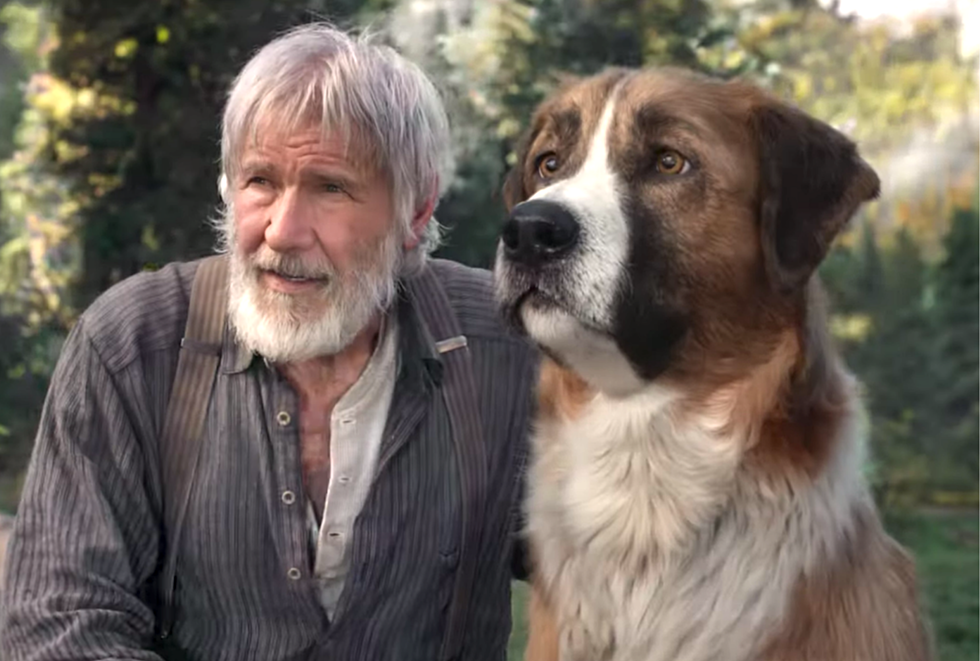Jim Schembri’s new release movie reviews 20 Feb, 2020

THE CALL OF THE WILD **** (100 minutes) PG
The century-old love affair between cinema and dogs shows no signs of waning with The Call of the Wild, a deeply enjoyable, eventful, spirited adventure that easily clocks in as one of the finest dog films we’ve seen since 2008’s record-setting Marley & Me – still the biggest dog film ever – as well as being one of the best things Harrison Ford has done in yonks.
Family-friendly to a fault and featuring some inventive and tense action scenes – nothing beats that menacing sound of ice cracking as you carefully traverse a frozen lake – the film’s tale of a dog in search of its own sense of family is often touching and is distinguished here by featuring a wonderfully expressive and lovable canine star who was created entirely inside a computer.
Based on the 1903 novel by Jack London – which has spawned no fewer than five previous films, including the 1935 Clark Gable/Loretta Young classic – the yarn is set largely in the mountainous, snow-swept landscape of the Yukon at the time of the gold rush.
This is where Buck, a large and loving St Bernard, has ended up after being dog-napped from his wealthy family home and sold as a pack dog to pull sleds across the snow.
Fortunately for Buck he joins a dog team run by a kindly, though stern postal worker Perrault (Omar Sy from The Intouchables) and Mercedes (Karen Gillan). Their job is to deliver mail along a 5000-mile route.
Having enjoyed the indulgences of upper-class domesticity, Buck now has to contend with the pecking order of the pack. He’s given the lowest position and has the least experience, yet he naively thinks he’s good enough to be top dog, a move that instantly puts him in conflict with the top dog.
After years enjoying his new life, Buck and the rest of his crew are declared redundant by the US Post Office as it embraces the speed of the telegram.
After suffering under the tyranny of a gold-hungry prospector, Buck bonds with Jack Thornton (Harrison Ford), a ragged old man who has left his loving wife to spare her his fathomless grief over the loss of their son.
Honouring the cherished dog-movie convention, the two become great friends as Thornton finds a connection with the dog he once shared with his son.
Hungry to explore the virgin wild, together they head into the uncharted territories beyond the borders of their maps, partly in the search of gold but chiefly to enjoy the soul-refreshing spiritual renewal that allegedly comes with trekking deep into nature.
For Thornton the experience is emotionally liberating, but for Buck this communing with the unsullied wilderness is transformative. Realizing that he is truly free for the first time, he undergoes a canine version of Roots as he bonds with a pack of friendly wolves who engage with him as part of their family.
What a lovely, superbly made family film this is. It’s the full dog movie package, blessed by the light-loving touch of cinematographer Janusz Kominski who won Oscars for his acclaimed work on Schindler’s List and Saving Private Ryan.
Directed with an intuitive and obvious love of dog movie lore by Chris Sanders (Lilo & Stitch; How to Train Your Dragon; The Croods; he also wrote a swag of Disney mega-hits such as Beauty and the Beast, The Lion King and Mulan) the film really pays out on traditional dog movie chestnuts such as friendship, loyalty, survival and character-forming journeys.
And while there is some narration provided to help the story move, many key scenes feature purely visual storytelling, which is a big – and brave – show of faith by the makers in the level of attention the audience, especially children, are paying.
Ironically, while The Call of the Wild is the latest film to celebrate the bravery, intuition and human-like emotion of dogs, it also issues fair warning to the dog actors of the world that their days are numbered.
You see, the canine star of Call of the Wild is a digitally rendered creature, and it’s an amazing, photo-realistic beast to behold. So, too, are all the other animals in a film that represents another high water mark in digital animation.
It’s some feat. Buck has all the flexibility and expressiveness you’d get with a cartoon dog, but the rendering is so realistic the only thing that gives it away is that a real dog, however well trained, simply could not emote and do all the physical things we see Buck do in a continuous take.
No doubt this film could have been made with real dogs and other animals, but the use of motion-capture technology – which gets more impressive with each big-screen application – gives filmmakers complete control over the action. Given the level of realism achieved here, it’s sobering to know that Buck was performed on set by a human, Terry Notary.
As well as being a stunt coordinator, Notary has worked as a movement coach and a performer on many films using motion capture technology, such as Avatar, the Hobbit films, Planet of the Apes, the last two Avengers films and The Lion King. Like Andy Serkis (he played Gollum in Lord of the Rings and the lead in King Kong) he’s spent most of his screen time mimicking animals.
And while digital technology has yet to deliver us computer-generated humans that look and feel real – giving rise to the “uncanny valley” phenomenon of sensing the strangeness of a figure that almost looks human – the really odd thing about the digital animals in Call of the Wild, and many other films such as Alpha and The Lion King, is that they don’t seem odd at all.
Even when these digital critters act and behave in ways real animals don’t, such as when they talk or emote, there’s a fidelity to the way they look and move that, bizarrely, rings true.
So while the “uncanny valley” afflicts digital humans, digital animals appear immune. It really underscores how much this technology is driven by art and the need for these digital creations to elicit real emotional responses from audiences.
So will animal actors soon be out of work and be replaced by people in green suits covered in tracking dots and sensors? Possibly.
If the cost of using a live animal is less than the cost of using motion capture – a very expensive and time-consuming process, to be sure – there will always be jobs for trainers and their charges, with low-budget films obviously going for the live animal option.
Still, the total control and total freedom that digital offers the director of an animal film must be enormously enticing.
Of course, as impressive as the acting of synthetic animals has been in so many films thus far – you really do feel for Buck in this film – you do know that they’re digital.
Few would dare argue that technological wizardry can replace the warmth and spontaneity of the real thing.
Not yet, anyway.
SONIC THE HEDGEHOG *** (99 minutes) PG
What’s the bet that a goodly percentage of the people presently cramming into cinemas to see Sonic the Hedgehog are motivated less by the prospect of seeing the titular video game character in a movie and more by the long-denied desire to see if Jim Carrey still be funny in a movie.
Yes, we all loved and laughed at the rubber-faced comedian in Ace Ventura, The Grinch, Dumb and Dumber, The Cable Guy and Liar Liar but you’ve got to go back some two decades to get to Carrey’s heyday.
Let’s face it, while we loved his dramatic excursions in films such as Eternal Sunshine of the Spotless Mind and Man on the Moon it’s been a long time since Jim Carrey brought the funny to a movie, as Mr Popper’s Penguins and The Incredible Burt Wonderstone attest.
In Sonic the Hedgehog Carrey is back in the over-the-top mode we love as he plays Dr Robotnik, a mean-spirited government tech genius who is tasked with tracking down and capturing Sonic, a spiky blue alien with the ability to move so fast he can make time appear to stand still.
Sonic has been living in hiding on earth for 20 years in the small town of Green Hills where he’s managed to avoid being detected, but for one old man who everyone considers crazy because of his Sonic sightings.
Having escaped the hostility on his home planet through a space/time portal created by one of the magic rings he carries with him, Sonic offsets his chronic loneliness by secretly bonding with the folk of the town. His favourite citizen is Tom (James Marsden), a local cop who dreams of bigger things for himself and his wife Maddie (Tika Sumpter), an animal doctor.
While in a sad state one night, Sonic runs around and around a baseball diamond so fast he creates a pulse of energy that knocks out the power in Green Hills, resulting in an official search for the source.
With a handlebar mustache fit for a Harley Davidson, Robotnik is called in and given full license by the government to deploy his fleet of drones to track Sonic down.
While trying to hide from Robotnik’s prying robots, Sonic encounters Tom for the first time and they bond. Through a mishap, Sonic’s precious rings have fallen through one of his magic portals and ended up on top of a building in San Francisco.
The film then becomes a road trip as Tom and Sonic try recovering the rings before Robotnik can catch up with them.
Unsurprisingly, Carrey manages to steal much of the film with his heightened mannerisms and scenery-chewing over-acting. It is a treat seeing him back in the zany mode that made Ace Ventura so funny. (Whatever happened to good old- fashioned zany?)
Still, director Jeffrey Fowler is smart enough not to allow Carrey’s antics to overshadow the friendship that develops between Sonic and Tom, which is the core of the film, and works nicely. There are also some nifty VFX-enhanced action sequences, the best being a bar fight in which Sonic uses his super speed to freeze time.
The film has hit big in the US, taking $US113 million since opejning on 14 February. While this would no doubt please the filmmakers no end, it must be especially reassuring to Carrey, who has been as central to the film’s marketing as Sonic himself and who must be glowing with the reaffirmation that, despite his many stumbles, he is still loved.
It’s also a vindication for the effort that went into creating Sonic for the big screen. Sega was not all that happy with the original humanesque design so, with a delayed release date (the film was meant to come out in November) and an extra $5 million, the digital artists went back to work and finally nailed it.
THE PROFESSOR AND THE MADMAN *** (125 minutes) M
Admittedly, the creation of the Oxford English Dictionary might not instantly sound like the basis for much of a movie, yet the combination of Mel Gibson and Sean Penn with a pretty compelling historical backstory ends up delivering a solid historical drama set against the worlds of 19th century academia and the confines of a psychiatric hospital.
Brandishing a very convincing accent and an even more convincing beard, Gibson plays James Murray, the man assigned the onerous job of putting together the definitive dictionary of the English language.
Dismissed by some as an impossible folly, the task is seen by its supporters as a powerful gesture of unification for the British Empire, for the compilation of words, Murray announces, is to be a collective project. People from all over the Empire will be invited to submit words and their definitions for inclusion in the massive tome, which Murray proudly boasts can be completed in five to seven years.
As the work progresses it emerges that one of the most dedicated contributors is an asylum inmate called William Chester Minor (Sean Penn). He’s under observation after he killed an innocent man during a nocturnal rampage.
As well as looking great – almost all British period films benefit from access to so many heritage-listed locales – the film has an appreciable degree of tension as the two men work together, sight unseen. While Murray deals with the scope of the work and his academic adversaries, Minor is beset by a slightly more severe degree of difficulty inside the asylum.
The lead performances are strong, especially from Gibson who sees in Minor the tragedy of a man who is working towards a form of redemption. Dwelling in a constant state of shame and guilt, Minor sends money to the family of his victim, which brings him in contact with the man’s widow, Eliza Merrett (Natalie Dormer). A most unexpected relationship develops and Penn sells it splendidly.
Based on the 1998 book The Surgeon of Crowthorne by Simon Winchester, Gibson had been developing the film for more than 20 years with a view to directing it himself. Ultimately, he handed the gig over to Farhad Safinia, who co-wrote Gibson’s Apocalypto, and who acquits himself very well here.
The film is as much about the love of words and of books as it is about the friendship between Minor and Murray, and it’s a theme Safinia lovingly rouses through some deftly composed dialogue and beautifully lit shots of shelves filled with gilt-edged volumes.
Unfortunately, the film’s director is officially credited as PB Shemran. This is due to a legal fracas between Gibson, Safinia and Icon (Gibson’s production house) and Voltage Pictures, which denied extra shooting days and final cut.
The sad post-settlement reality is that Gibson and Safinia abandoned the film and did nothing to support it. Consequently, the film has had a very small public. It’s an unworthy fate for such a fine film.















